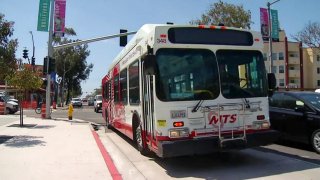
San Diego’s Metropolitan Transit System will soon reduce bus routes after seeing a steep decrease in ridership amid the government’s stay at home order.
Beginning April 13, the routes will be reduced and passengers will no longer be allowed to pay with cash to take the bus, according to MTS spokesperson Marcial Gutiérrez. Ridership has decreased by 65% as a result of last month’s stay at home order.
MTS officials noted that transportation services were still considered essential but should be only utilized by those conducting essential tasks, like going to the grocery store, refilling a prescription or attending a necessary doctor's appointment.
“For your own benefit, for our employees' benefit, for your fellow citizens' benefit, if you don’t need to ride, don’t ride. Stay Home. But if you do, we want to provide that benefit for you," said MTS Chief Executive Officer Paul Jablonski said.
MTS also confirmed Monday one of their bus drivers has tested positive for the new coronavirus, becoming the first frontline MTS worker to be infected with the disease.
The employee was operating a minibus route but was not symptomatic during their shift. Jablonski said a minimal amount of riders utilize the minibus service and notices will be posted on buses in the employee's route. The employee's last day of work was Thursday and the positive test was confirmed on Sunday.
MTS Changes
Local
While the majority of bus routes will see reduced frequency, no routes will be discontinued or eliminated, Jablonski said.
Trolley service will continue, for the most part, as usual. The blue line will reduce its frequency to every 15 minutes during the off-peak afternoon hours. Green and Orange lines will operate as usual.
See the most updated schedules here.
Jablonski said he is confident the about 25 percent reduction in service will not affect their efforts to social distance on buses and trolleys. And, if necessary, full service can be re-initiated in a matter of days.
Adding to the new changes, seniors and those who have special needs will be able to enter buses through its front doors, but all other passengers will be required to enter through the back doors.
Bus drivers are still not required by law to wear face masks, but MTS officials are working on providing supplies like hand sanitizer, masks, and gloves to them, Gutiérrez said.
Policies that were already in effect following a public health order from the county of San Diego remain in effect. Those include: ticket inspections that occur on the platform instead of on buses or trolleys and extra bus cleanings, among others.
On Friday, Supervisor Nathan Fletcher called April a pivotal month for San Diego County in discovering how severe the pandemic will affect the region.
"We believe this is the month where we find out if we end up like Italy or New York or if we find ourselves through a better pathway and a better direction,” he said.
For the latest information on the coronavirus pandemic in San Diego County, click here.



